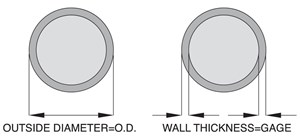Tubing comes in a variety of gauges (sometimes spelled ‘gage’ and abbreviated as ga.). This term refers to the wall thickness of the material. Popular gauges of tube are 10, 11, 12, 13, 14, 16, 18, and 20. The lower the gauge the greater the wall thickness of the tube. For example 10 gauge tube equals .134 inch wall thickness whereas 20 gauge tube is .035 inch.
This measurement remains consistent among the various tube sizes. For example, the thickness for 10 gauge tube will consistently measure .134 inch, whether it is 1-1/2 in. O.D., 2 in. O.D., or 4-1/2 in. O.D. tube. This measurement is part of the naming convention, also. For instance, a tube with an outside diameter of 1-1/2 inches and a wall thickness of .065 inch is called out or named 1-1/2 inch x 16 gauge tube.

Popular Tube Sizes and Gauges
The most commonly requested gauges of tubing are 10, 11, 12, 13, 14, 16, 18 and 20. tube gauge. If you convert this to inches, it looks like this:
10 gauge = .134 inches
11 gauge = .120 inches
12 gauge = .109 inches
13 gauge = .095 inches
14 gauge = .083 inches
16 gauge = .065 inches
18 gauge = .049 inches
20 gauge = .035 inches
Where did this terminology come from? Gauges are old measures of thickness. They originated in the British iron wire industry at a time when there was no universal unit of thickness. The sizes of the gauge numbers were the result of the process of wire-drawing and the nature of iron as a substance.1
For more information, please see our long-form post: Pipe and Tube: What is the Difference (click here).
1J. S. Pöll Haaglanden Medical Centre, Westeinde Hospital, PO Box 432, 2501 CK The Hague, The Netherlands